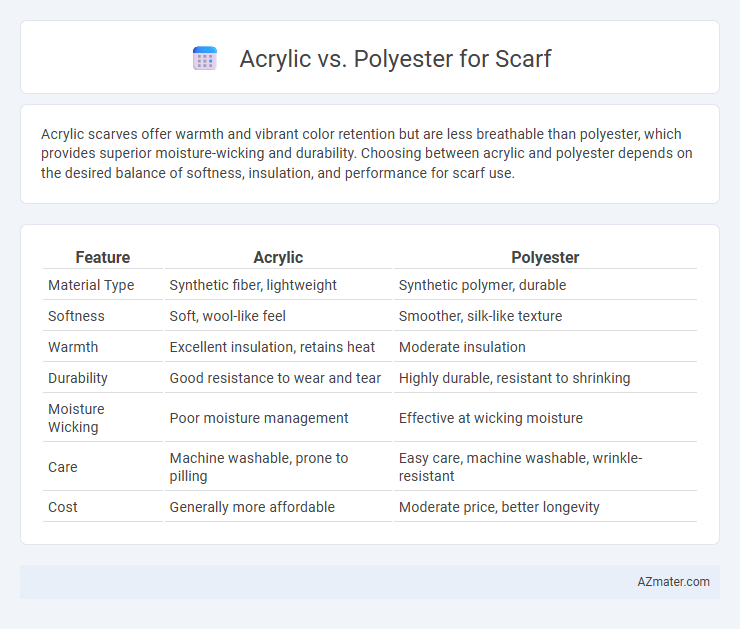Acrylic scarves offer warmth and vibrant color retention but are less breathable than polyester, which provides superior moisture-wicking and durability. Choosing between acrylic and polyester depends on the desired balance of softness, insulation, and performance for scarf use.
Table of Comparison
| Feature | Acrylic | Polyester |
|---|---|---|
| Material Type | Synthetic fiber, lightweight | Synthetic polymer, durable |
| Softness | Soft, wool-like feel | Smoother, silk-like texture |
| Warmth | Excellent insulation, retains heat | Moderate insulation |
| Durability | Good resistance to wear and tear | Highly durable, resistant to shrinking |
| Moisture Wicking | Poor moisture management | Effective at wicking moisture |
| Care | Machine washable, prone to pilling | Easy care, machine washable, wrinkle-resistant |
| Cost | Generally more affordable | Moderate price, better longevity |
Introduction to Acrylic and Polyester Scarves
Acrylic scarves are crafted from synthetic fibers known for their softness, warmth, and resistance to wrinkles and fading, making them a durable choice for everyday wear. Polyester scarves, also synthetic, offer excellent moisture-wicking properties, high color retention, and a smooth texture that resists shrinking and stretching. Both materials provide affordable alternatives to natural fibers, each with distinct qualities suited for different style and comfort preferences.
Material Composition and Properties
Acrylic scarves are made from a synthetic fiber known for its softness, warmth, and ability to mimic wool, making them lightweight and resistant to moths and chemicals. Polyester scarves consist of a durable, wrinkle-resistant synthetic polymer that offers excellent moisture-wicking properties and color retention, ensuring vibrant hues over extended use. Both materials provide strong durability, but acrylic tends to offer better insulation, while polyester excels in moisture management and quick drying.
Softness and Comfort Comparison
Acrylic scarves offer a soft, lightweight feel that mimics natural fibers, providing warmth and comfort ideal for sensitive skin. Polyester scarves, while durable and wrinkle-resistant, tend to be less breathable and can feel less soft against the skin compared to acrylic. Choosing acrylic enhances overall softness and coziness, making it a preferred option for comfortable winter accessories.
Breathability and Warmth Differences
Acrylic scarves offer excellent warmth due to their ability to retain heat, making them ideal for colder weather, but their breathability is limited compared to polyester. Polyester scarves provide better breathability and moisture-wicking properties, allowing for more comfort in mild or variable temperatures while still offering moderate insulation. Choosing between acrylic and polyester depends on prioritizing maximum warmth or enhanced breathability for scarf use.
Durability and Longevity
Polyester scarves are renowned for their exceptional durability, resisting stretching, shrinking, and wrinkles over extended use, which enhances their longevity. Acrylic scarves mimic the softness of wool but tend to pill and show wear faster, reducing their lifespan compared to polyester. Choosing polyester ensures a long-lasting, resilient scarf that maintains its shape and appearance even after frequent washing.
Moisture-Wicking and Quick-Drying Abilities
Polyester scarves excel in moisture-wicking and quick-drying abilities due to their synthetic fibers that efficiently pull sweat away from the skin and evaporate moisture rapidly. Acrylic scarves, while warm and soft, lack the same breathability and moisture management properties, making them less effective in keeping the wearer dry during physical activity. Choosing polyester enhances comfort in active or humid conditions by minimizing dampness and promoting faster drying times.
Color Retention and Design Options
Acrylic scarves offer excellent color retention due to their synthetic fibers, ensuring vibrant hues that resist fading even after multiple washes. Polyester scarves also maintain color well but provide a broader range of design options thanks to their ability to hold intricate digital prints and vibrant patterns. Both materials excel in durability, but polyester's versatility in design makes it a preferred choice for scarves with detailed graphics and rich color complexity.
Ease of Care and Maintenance
Polyester scarves are highly valued for their durability and resistance to wrinkles, making them easy to care for with simple machine washing and quick drying properties. Acrylic scarves, while soft and warm, often require gentle hand washing to maintain their texture and prevent damage such as pilling. Both materials offer low-maintenance options, but polyester's stain resistance and color retention provide superior ease of care for everyday use.
Sustainability and Environmental Impact
Polyester scarves, derived from petroleum-based synthetic fibers, contribute to microplastic pollution and have a high carbon footprint due to energy-intensive production processes. Acrylic fibers, also synthetic, release harmful chemicals during manufacturing and are non-biodegradable, leading to long-term environmental accumulation. Choosing scarves made from recycled polyester or organic alternatives significantly reduces environmental impact and enhances sustainability.
Final Verdict: Which is Better for Scarves?
Polyester scarves offer superior durability, moisture resistance, and vibrant color retention, making them ideal for everyday wear and outdoor activities. Acrylic scarves provide excellent warmth and softness, closely mimicking wool, which is perfect for colder climates but may lack the breathability of polyester. For versatility and long-lasting quality, polyester scarves generally outperform acrylic, especially in terms of maintenance and resistance to wear.

Infographic: Acrylic vs Polyester for Scarf
 azmater.com
azmater.com